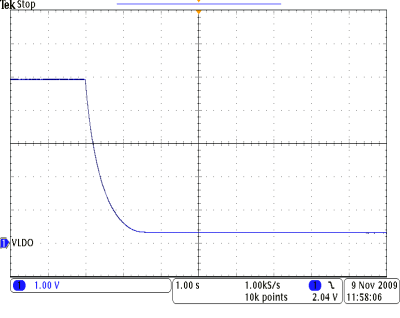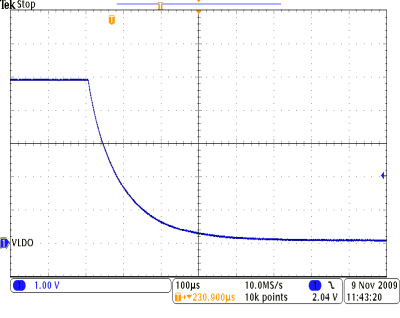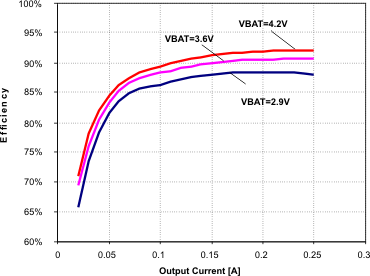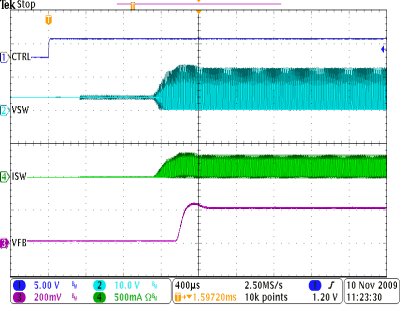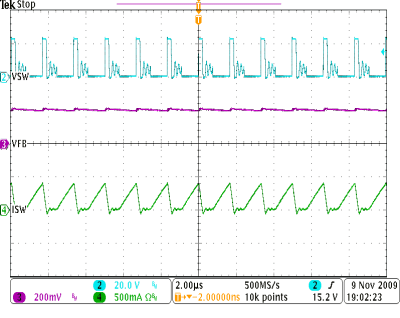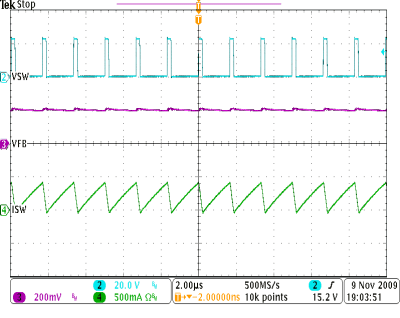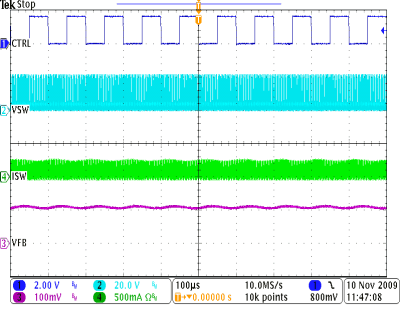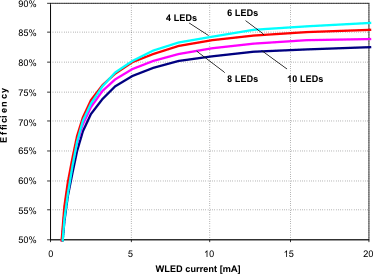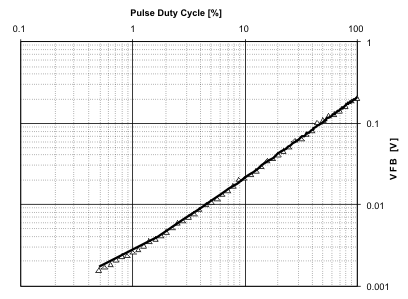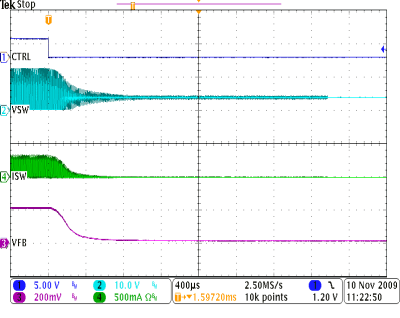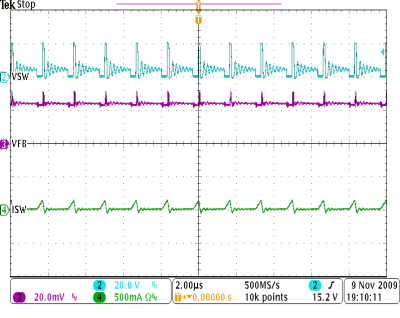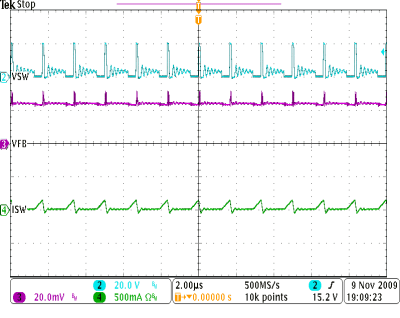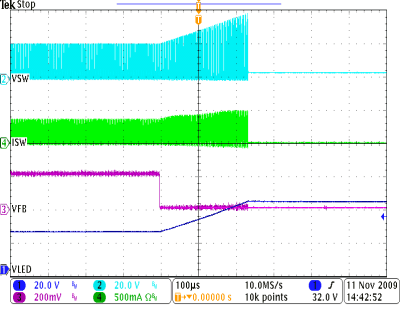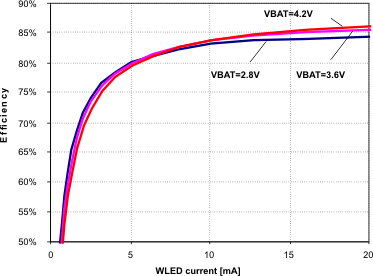| INPUT CURRENTS |
| IDISCHARGE |
Battery discharge current in high Impedance mode (CSIN, CSOUT,SWC, SWL, BAT, VSYS pins) |
0°C < TJ < 85°C,
VBAT = 4.2 V |
Charger Hi-Z mode
WLED disabled
Shunt monitor disabled |
|
2 |
10 |
µA |
Charger Hi-Z mode
WLED enabled, no load
Shunt monitor disabled |
|
|
1800 |
| Charger HiZ mode WLED disabled Shunt monitor enabled |
|
|
60 |
| IVBUS |
VBUS supply current |
VBUS > VBUS(min) |
Charger PWM ON |
|
10000 |
|
µA |
| Charger PWM OFF |
|
|
5000 |
| 0°C < TJ < 85°C, HZ_MODE = 1 |
|
|
15 |
| IVBUS_LEAK |
Leakage current from battery to VBUS pin |
0°C < TJ < 85°C, VBAT = 4.2 V HiZ mode |
|
|
5 |
µA |
| VOLTAGE REGULATION |
| VOREG |
Output charge voltage |
Operating in voltage regulation, programmable |
3.5 |
|
4.44 |
V |
| Voltage regulation accuracy |
TA = 25°C |
–0.5% |
|
0.5% |
|
| Full temperature range |
–1% |
|
1% |
| CURRENT REGULATION -FAST CHARGE |
| IOCHARGE |
Output charge current |
VSHRT ≤ VCSOUT < VOREG
VBUS > 5 V, RSNS = 20 mΩ,
LOW_CHG = 0, Programmable |
550 |
|
1250 |
mA |
VLOWV ≤ VCSOUT < VOREG,
VBUS > 5 V, RSNS = 20 mΩ,
LOW_CHG = 1 |
|
150 |
200 |
| CHARGE TERMINATION DETECTION |
| ITERM |
Termination charge current |
VCSOUT > VOREG-VRCH, VBUS > 5 V,
RSNS = 20 mΩ, Programmable |
50 |
|
400 |
mA |
|
Deglitch time for charge termination |
Both rising and falling, 2-mV overdrive,
tRISE, tFALL = 100 ns |
|
30 |
|
ms |
| CHARGE CURRENT ACCURACY |
| VOS, CHRGR |
Offset voltage, sense voltage amplifier
Charge current accuracy = VOS/(ISETxRSNS) |
TA = 0°C to 85°C |
–1 |
|
1 |
mV |
| BAD ADAPTOR DETECTION |
| VIN(MIN) |
Input voltage lower limit |
Bad adaptor detection, VBUS falling |
3.6 |
3.8 |
4 |
V |
| Deglitch time for VBUS rising above VIN(MIN) |
Rising voltage, 2-mV over drive,
tRISE = 100 ns |
|
30 |
|
ms |
| Hysteresis for VIN(MIN) |
VBUS rising |
100 |
|
200 |
mV |
| IADET |
Current source to GND |
During bad adaptor detection |
20 |
30 |
40 |
mA |
| TINT |
Detection interval |
Input power source detection |
|
2 |
|
s |
| INPUT BASED DYNAMIC POWER MANAGEMENT |
| VIN_LOW |
The threshold when input based DPM loop kicks in |
Charge mode, programmable |
4.2 |
|
4.76 |
V |
| DPM loop kick-in threshold tolerance |
|
–2% |
|
2% |
|
| INPUT CURRENT LIMITING |
| IIN_LIMIT |
Input current limiting threshold |
IIN_LIMIT = 100 mA |
88 |
93 |
98 |
mA |
| IIN_LIMIT = 500 mA |
450 |
475 |
500 |
| IIN_LIMIT = 975 mA |
875 |
925 |
975 |
| VDD REGULATOR |
| VDD |
Internal bias regulator voltage |
VBUS > VIN(min) or VSYS > VBATMIN,
IVDD = 1 mA, CVDD = 1 μF |
2 |
|
6.5 |
V |
| VDD output short current limit |
|
|
30 |
|
mA |
| Voltage from BST pin to SWC pin |
During charge or boost operation |
|
|
6.5 |
V |
| BATTERY RECHARGE THRESHOLD |
| VRCH |
Recharge threshold voltage |
Below VOREG |
100 |
130 |
160 |
mV |
| Deglitch time |
VCSOUT decreasing below threshold,
tFALL = 100 ns, 10-mV overdrive |
|
130 |
|
ms |
| STAT OUTPUT |
| VOL(STAT) |
Low-level output saturation voltage |
IO = 10 mA, sink current |
|
|
0.4 |
V |
| High-level leakage current |
Voltage on STAT pin is 5 V |
|
|
1 |
µA |
| REVERSE PROTECTION COMPARATOR |
| VREV |
Reverse protection threshold, VBUS-VCSOUT |
2.3 V ≤ VCSOUT ≤ VOREG, VBUS falling |
0 |
40 |
100 |
mV |
| VREV-EXIT |
Reverse protection exit hysteresis |
2.3 V ≤ VCSOUT ≤ VOREG |
140 |
200 |
260 |
mV |
| Deglitch time for VBUS rising above VREV + VREV_EXIT |
Rising voltage |
|
30 |
|
ms |
| VBUS UVLO |
| VUVLO |
IC active threshold voltage |
VBUS rising |
3.05 |
3.3 |
3.55 |
V |
| VUVLO_HYS |
IC active hysteresis |
VBUS falling from above VUVLO |
120 |
150 |
|
mV |
| PWM |
| fPWM |
PWM frequency, charger |
|
|
3 |
|
MHz |
| RDSON |
Internal top reverse blocking
MOSFET on-resistance |
IIN_LIMIT = 500 mA,
Measured from VBUS to PMID |
|
180 |
|
mΩ |
Internal top N-channel Switching
MOSFET on-resistance |
Measured from PMID to SWC |
|
120 |
|
Internal bottom N-channel
MOSFET on-resistance |
Measured from SW to PGND |
|
150 |
|
| DMAX |
Maximum duty cycle |
|
|
99.5% |
|
|
| DMIN |
Minimum duty cycle |
|
0% |
|
|
|
|
Synchronous mode to nonsynchronous mode transition current threshold(1) |
Low-side MOSFET
cycle-by-cycle current sensing |
|
100 |
|
mA |
| BOOST MODE OPERATION FOR VBUS (OPA_MODE=1, HZ_MODE=0) |
| VBUS_B |
Boost output voltage (to pin VBUS) |
2.5 V < VBUS < 4.5 V; Including line and load regulation over full temp range |
4.75 |
5 |
5.25 |
V |
| IBO |
Maximum output current for boost |
VBUS_B = 5 V, 2.5 V < VBUS < 4.5 V |
200 |
|
|
mA |
| IBLIMIT |
Cycle by cycle current limit for boost |
VBUS_B = 5 V, 2.5 V < VSYS < 4.5 V |
|
1 |
|
A |
| VBUSOVP |
Overvoltage protection threshold for boost (VBUS pin) |
Threshold over VBUS to turn off converter during boost |
5.8 |
6 |
6.2 |
V |
| VBUSOVP hysteresis |
VBUS falling from above VBUSOVP |
|
200 |
|
mV |
| VBATMAX |
Maximum battery voltage for boost |
VSYS rising edge during boost |
4.75 |
4.9 |
5.05 |
V |
| VBATMAX hysteresis |
VSYS falling from above VBATMAX |
|
200 |
|
mV |
| VBATMIN |
Minimum battery voltage for boost (VSYS pin) |
During boosting |
|
2.5 |
|
V |
| Before boost starts |
|
2.9 |
3.05 |
|
Boost output resistance at high impedance mode (From VBUS to PGND) |
HZ_MODE = 1 |
500 |
|
|
kΩ |
| CHARGER PROTECTION |
| VOVP-IN_USB |
Input VBUSOVP threshold voltage |
Threshold over VBUS to turn off converter during charge |
6.3 |
6.5 |
6.7 |
V |
| VOVP_IN_USB hysteresis |
VBUS falling from above VOVP_IN |
|
140 |
|
mV |
| VOVP |
Battery OVP threshold voltage |
VCSOUT threshold over VOREG to turn off charger during charge (% VOREG) |
110% |
117% |
121% |
|
| VOVP hysteresis |
Lower limit for VCSOUT falling from > VOVP (% VOREG) |
|
11% |
|
|
| ILIMIT |
Cycle-by-cycle current limit for charge |
Charge mode operation |
1.8 |
2.4 |
3 |
A |
| VSHORT |
Trickle to fast charge threshold |
VCSOUT rising, VSHRT connected to VDD |
2 |
2.1 |
2.2 |
V |
| Resistor connected from VSHRT to GND |
1.8 |
|
VBUS – 0.7 |
V |
| Internal current source connected to VSHRT pin |
|
9.4 |
10 |
10.6 |
µA |
| VSHORT hysteresis |
VCSOUT falling from above VSHORT |
|
100 |
|
mV |
| Enable threshold for internal VSHORT reference |
percentage of VDD |
|
90% |
|
|
| ISHORT |
Trickle charge charging current |
VCSOUT ≤ VSHORT |
20 |
30 |
40 |
mA |
| TCF |
Thermal regulation threshold |
Charge current begins to taper down |
|
120 |
|
°C |
| T32S |
Time constant for the 32-second timer |
32 second mode |
|
32 |
|
s |
| WLED VOLTAGE AND CURRENT CONTROL |
| VREF |
Voltage feedback regulation voltage |
|
198 |
203 |
208 |
mV |
| VREF_PWM |
Voltage feedback regulation voltage under brightness control |
VFB[4:0] = 01110 (VFB = 25%) |
47 |
50 |
53 |
mV |
| VFB[4:0] = 01110 (VFB = 10%) |
17 |
20 |
23 |
| fCTRL |
PWM dimming frequency |
|
1 |
|
100 |
kHz |
| tCNTRL, MIN |
Minimum on-time for PWM dimming pulse |
|
2.2 |
|
|
µs |
| IFB |
Voltage feedback input bias current |
VFB = 200 mV |
|
|
1 |
µA |
| fPWM |
PWM frequency, WLED boost |
|
|
600 |
|
kHz |
| Dmax |
Maximum duty cycle |
VFB = 100 mV |
90% |
93% |
|
|
| tmin_on |
Minimum 0N pulse width |
|
|
40 |
|
ns |
| L |
Inductor |
|
10 |
|
22 |
µH |
| COUT |
Output capacitor |
|
0.47 |
|
10 |
µF |
| WLED POWER SWIITCH |
| RDS(on) |
N-channel MOSFET on-resistance |
VSYS = 3.6 V |
|
300 |
600 |
mΩ |
| ILN_NFET |
N-channel leakage current |
VSWL = 30 V, TA = 25°C |
|
|
1 |
µA |
| WLED PROTECTION |
| VUVLO |
Under Voltage Lock Out (VSYS pin) |
VSYS falling |
|
2.2 |
2.5 |
V |
| UVLO hysteresis |
|
|
70 |
|
mV |
| VOVP |
Overvoltage Protection threshold |
|
35 |
37 |
39 |
V |
| ILIM |
N-Channel MOSFET current limit |
D = Dmax |
560 |
700 |
840 |
mA |
| ILIM_Start |
Startup current limit |
D = Dmax |
|
400 |
|
mA |
| tHALF_LIM |
Time step for half current limit |
|
|
5 |
|
ms |
| tREF |
VREF filter time constant |
|
|
180 |
|
µs |
| tstep |
VREF ramp up time |
|
|
213 |
|
µs |
| CURRENT SHUNT MONITOR |
| VCM |
Common-mode input range |
VCSIN = VCSOUT |
–0.3 |
|
7 |
V |
| CMR |
Common-mode rejection |
VCSIN = 2.7 V to 5 V, VCSIN – VCSOUT = 0 mV |
100 |
|
|
dB |
| VOS, CSM |
Offset-voltage, referred to input |
TA = 0°C to 60°C |
–75 |
|
75 |
µV |
| TA = -20°C to 85°C |
–85 |
|
85 |
| G |
Gain |
|
|
25 |
|
V/V |
| Gain error |
|
–1% |
|
1% |
|
| VSHNT |
Swing to positive power supply rail (VSYS) |
VSYS - VSHNT |
100 |
|
|
mV |
| Swing to GND |
VSHNT - VGND |
100 |
|
|
| GBW |
Bandwidth |
CLOAD = 10 pF |
|
9 |
|
kHz |
| IVZERO |
VZERO bias current |
TA = -20°C to 85°C |
|
|
10 |
nA |
| VZERO |
Swing to positive power supply rail (VSYS) |
VSYS – VZERO |
1.5 |
|
|
V |
| Swing to GND |
VZERO - VGND |
0.7 |
|
|
| VUVLO |
Undervoltage lockout (VSYS pin) |
VSYS falling |
|
2.2 |
2.5 |
V |
| UVLO hysteresis |
|
|
70 |
|
mV |
| LDO |
| VLDO |
LDO Output Voltage |
VIN = 5.5V |
4.8 |
4.9 |
5 |
V |
| PSRR |
f = 100 Hz, CLDO = 1.0 μF |
|
60 |
|
dB |
| ILDO |
Maximum LDO Output Current |
|
60 |
|
|
mA |
| VDO |
Dropout Voltage |
VIN = 4.5 V, ILDO = 50 mA |
|
100 |
250 |
mV |
| D+/D- DETECTION |
| VDP_SCR |
D+ voltage source |
|
0.5 |
0.6 |
0.7 |
V |
| D+ voltage source output current |
|
250 |
|
|
µA |
| IDM_SINK |
D- current sink |
|
50 |
100 |
150 |
µA |
| CI |
Input capacitance |
DM pin, switch open |
|
4.5 |
5 |
pF |
| DP pin, switch open |
|
4.5 |
5 |
| II |
Input leakage |
DM pin, switch open |
–1 |
|
1 |
µA |
| DP pin, switch open |
–1 |
|
1 |
| VDP_LOW |
DP low comparator threshold |
|
0.8 |
|
|
V |
| VDM_HIGH |
DM high comparator threshold |
|
0.8 |
|
|
V |
| VDM_LOW |
DM low comparator threshold |
|
|
|
475 |
mV |
| LOGIC LEVELS AND TIMING CHARTERISTICS (SCL, SDA, CTRL, INT) |
| VOL |
Output low threshold level |
IO = 3 mA, sink current (SDA, INT) |
|
|
0.4 |
V |
| Input low threshold level |
|
|
|
0.4 |
| Input high threshold level |
|
1.2 |
|
|
| I(bias) |
Input bias current (SCL, SDA, INT) |
VIO = 1.8 V |
|
|
1 |
µA |
| fSCL |
SCL clock frequency |
|
|
|
400 |
kHz |
| RCTRL |
CTRL pulldown resistor |
|
400 |
800 |
1600 |
kΩ |
| tOFF |
CTRL pulse width to shutdown |
CTRL high to low |
2.5 |
|
|
ms |
|
7-bit slave address |
|
1101 010 |
|
| OSCILLATOR |
| fOSC |
Oscillator frequency |
|
|
3 |
|
MHz |
| Frequency accuracy |
TA = –40°C to 85°C |
–10% |
|
10% |
|
| THERMAL SHUTDOWN |
| TSHTDWN |
Thermal trip point |
|
|
165 |
|
°C |
| Thermal hysteresis |
|
|
10 |
|
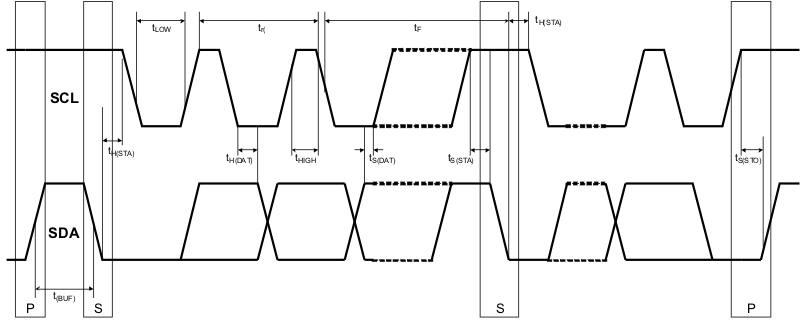 Figure 1. I2C Data Transmission Timing
Figure 1. I2C Data Transmission Timing
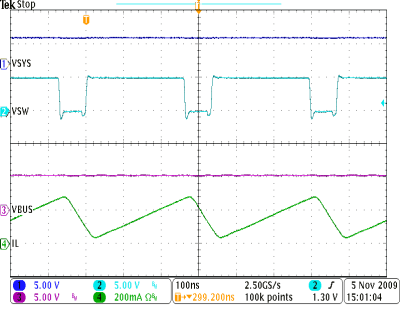
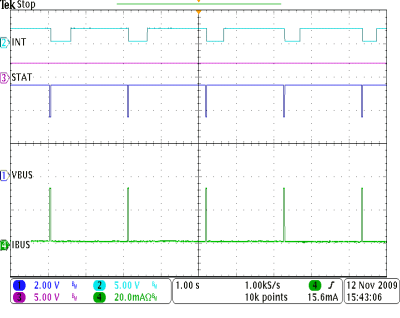
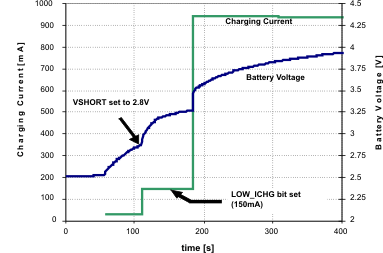
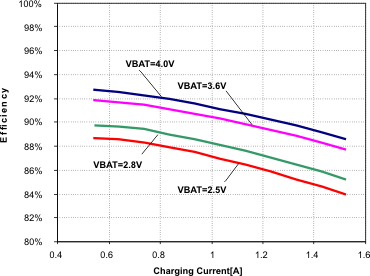
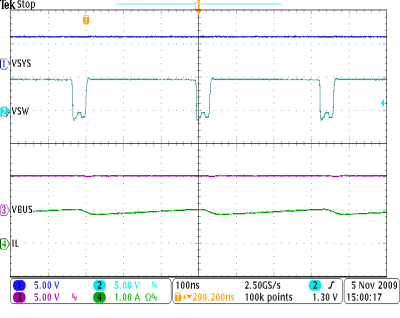
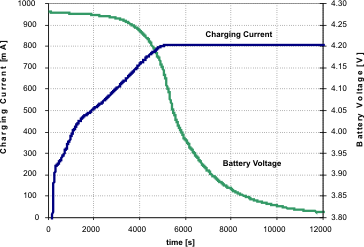
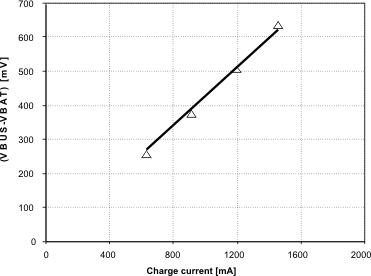 Figure 7. Effective Dropout Voltage
Figure 7. Effective Dropout Voltage
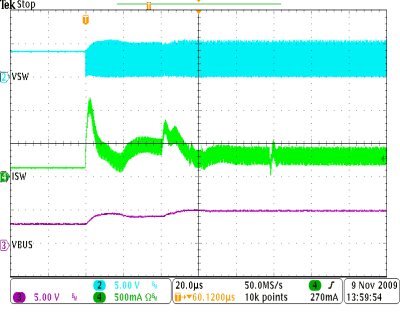
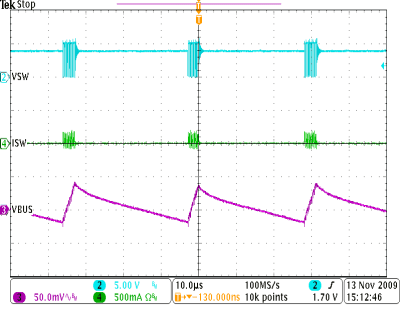
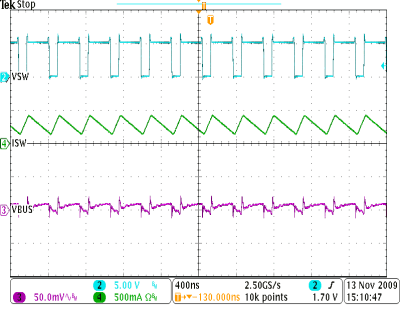
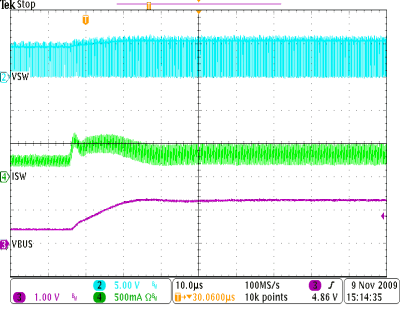
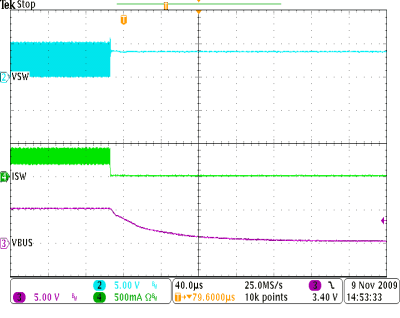
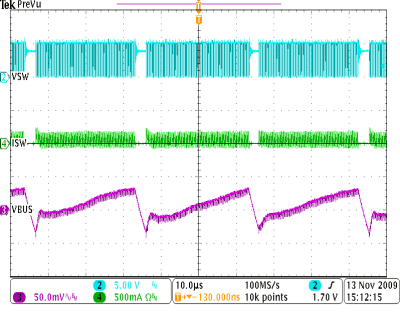
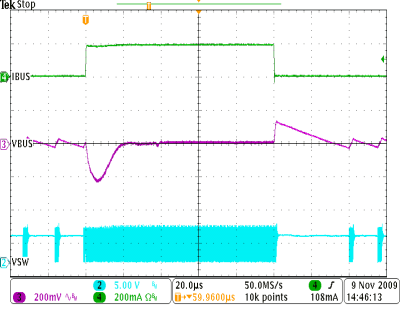
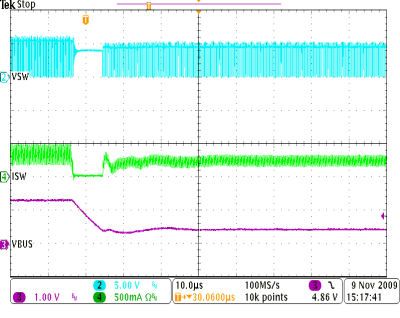
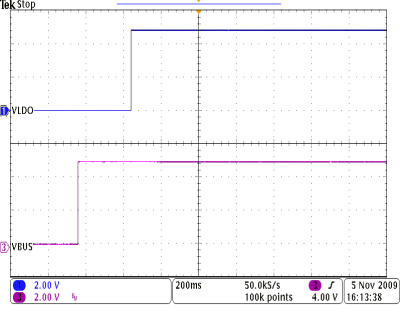 Figure 17. Turnon Delay
Figure 17. Turnon Delay
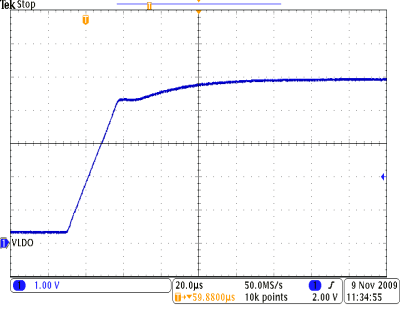
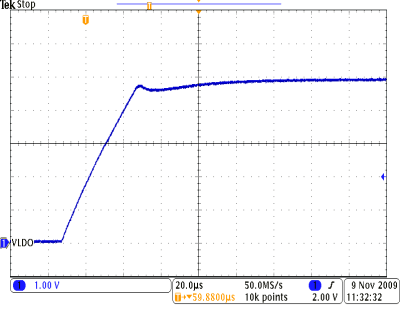
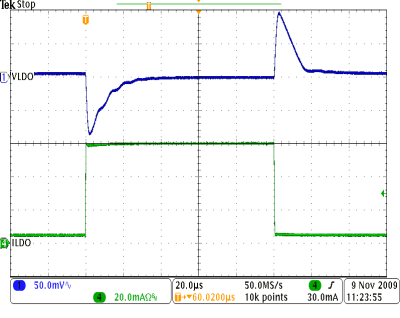
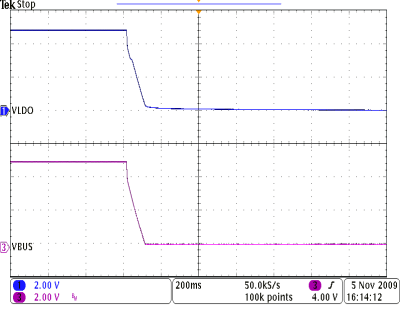 Figure 18. Turnoff Delay
Figure 18. Turnoff Delay
